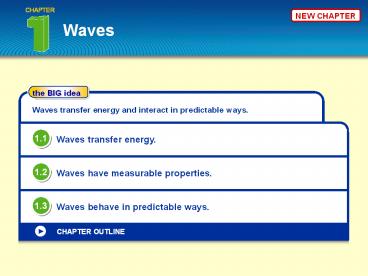NEW CHAPTER - PowerPoint PPT Presentation
1 / 10
Title:
NEW CHAPTER
Description:
CHAPTER NEW CHAPTER Waves the BIG idea Waves transfer energy and interact in predictable ways. 1.1 Waves transfer energy. 1.2 Waves have measurable properties. – PowerPoint PPT presentation
Number of Views:162
Avg rating:3.0/5.0
Title: NEW CHAPTER
1
CHAPTER
NEW CHAPTER
Waves
Waves transfer energy and interact in predictable
ways.
1.1
Waves transfer energy.
1.2
Waves have measurable properties.
1.3
Waves behave in predictable ways.
2
Waves transfer energy.
1.1
wave
medium
mechanical wave
transverse wave
longitudinal wave
SECTION OUTLINE
3
Waves transfer energy.
1.1
wave
medium
mechanical wave
transverse wave
longitudinal wave
SECTION OUTLINE
4
wave
1.1
Waves transfer energy.
wave
medium
mechanical wave
A disturbance that transfers energy from one
place to another without requiring matter to move
the entire distance.
transverse wave
longitudinal wave
KEY CONCEPT SUMMARY
5
medium
1.1
Waves transfer energy.
wave
medium
mechanical wave
A substance through which a wave moves.
transverse wave
longitudinal wave
KEY CONCEPT SUMMARY
6
mechanical wave
1.1
Waves transfer energy.
wave
medium
mechanical wave
A wave, such as a sound wave or a seismic wave,
that transfers kinetic energy through matter.
transverse wave
longitudinal wave
KEY CONCEPT SUMMARY
7
transverse wave
1.1
Waves transfer energy.
wave
medium
mechanical wave
A type of wave in which the disturbance moves at
right angles, or perpendicular, to the direction
in which the wave travels.
transverse wave
longitudinal wave
KEY CONCEPT SUMMARY
8
longitudinal wave
1.1
Waves transfer energy.
wave
medium
mechanical wave
A type of wave in which the disturbance moves in
the same direction that the wave travels.
transverse wave
longitudinal wave
KEY CONCEPT SUMMARY
9
Waves have measurable properties.
1.2
crest
trough
amplitude
wavelength
frequency
Frequency is the number of wavelengths passing a
fixed point in a certain amount of time.
SECTION OUTLINE
10
crest
1.2
Waves have measurable properties.
crest
trough
amplitude
The highest point, or peak, of a wave.
wavelength
frequency
KEY CONCEPT SUMMARY
11
trough
1.2
Waves have measurable properties.
crest
trough
amplitude
The lowest point, or valley, of a wave.
wavelength
frequency
KEY CONCEPT SUMMARY
12
amplitude
1.2
Waves have measurable properties.
crest
trough
amplitude
The maximum distance that a disturbance causes a
medium to move from its rest position the
distance between a crest or trough of a wave and
line through the center of a wave.
wavelength
frequency
KEY CONCEPT SUMMARY
13
wavelength
1.2
Waves have measurable properties.
crest
trough
amplitude
The distance from one wave crest to the next
crest, or from any part of one wave to the
identical part on the next wave.
wavelength
frequency
KEY CONCEPT SUMMARY
14
frequency
1.2
Waves have measurable properties.
crest
trough
amplitude
The number of wavelengths (or wave crests) that
pass a fixed point in a given amount of time,
usually one second.
wavelength
frequency
KEY CONCEPT SUMMARY
15
Waves behave in predictable ways.
1.3
Reflection
reflection
refraction
diffraction
interference
SECTION OUTLINE
16
Waves behave in predictable ways.
1.3
Refraction
reflection
refraction
diffraction
interference
SECTION OUTLINE
17
Waves behave in predictable ways.
1.3
Diffraction
reflection
refraction
diffraction
interference
SECTION OUTLINE
18
reflection
1.3
Waves behave in predictable ways.
reflection
refraction
The bouncing back of a wave after it strikes a
barrier.
diffraction
interference
KEY CONCEPT SUMMARY
19
refraction
1.3
Waves behave in predictable ways.
reflection
refraction
The bending of a wave as it crosses the boundary
between two mediums at an angle other than 90
degrees.
diffraction
interference
KEY CONCEPT SUMMARY
20
diffraction
1.3
Waves behave in predictable ways.
reflection
refraction
The spreading out of waves as they pass through
an opening or around the edges of an obstacle.
diffraction
interference
KEY CONCEPT SUMMARY
21
interference
1.3
Waves behave in predictable ways.
reflection
refraction
The meeting and combining of waves the adding or
subtracting of wave amplitudes that occurs as
waves overlap.
diffraction
interference
KEY CONCEPT SUMMARY
22
1.1
Waves transfer energy.
I. Waves transfer energy.
wave
A. A wave is a disturbance.
medium
1. Forces and Waves
mechanical wave
2. Materials and Waves
transverse wave
longitudinal wave
3. Energy and Waves
B. Waves can be classified by how they move.
1. Transverse Waves
2. Longitudinal Waves
KEY CONCEPT SUMMARY
23
Waves have measurable properties.
1.2
II. Waves have measurable properties.
crest
A. Waves have amplitude, wavelength, and
frequency.
trough
amplitude
1. Measuring Wave Properties
wavelength
2. How Frequency and Wavelength Are Related
frequency
3. Graphing Wave Properties
B. Wave speed can be measured.
KEY CONCEPT SUMMARY
24
Waves behave in predictable ways.
1.3
III. Waves behave in predictable ways.
reflection
A. Waves interact with materials.
refraction
1. Reflection
diffraction
2. Refraction
interference
3. Diffraction
B. Waves interact with other waves.
1. Waves Adding Together
2. Waves Canceling Each Other Out
KEY CONCEPT SUMMARY

